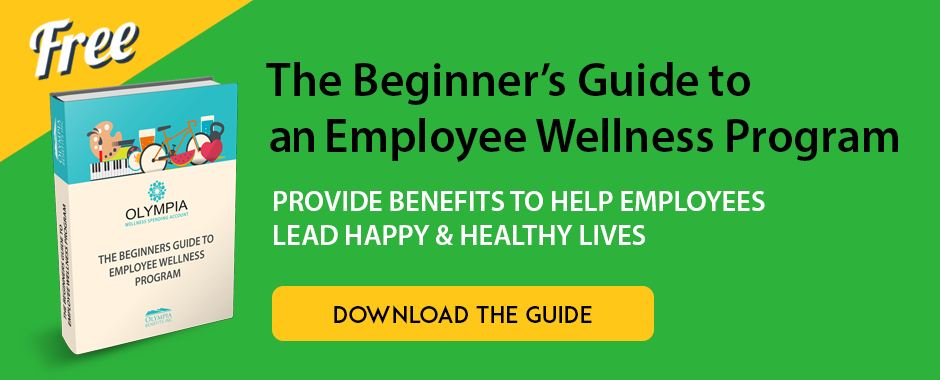There is a lot of confusion online when it comes to employee wellness programs. Articles preach the benefits or disadvantages without providing any basis for their claims. For business owners, it may feel like a way to get pricey "perks" added to the company in the interest of fun.
Some truths:
- A true employee wellness program is an essential component of an organization (and it doesn't just mean providing free yoga classes at lunch).
- Employee wellness programs don't have to be complicated or expensive, but they do require some strategic thinking and realistic expectations.
In this article, we'll explore what an employee wellness program really is and will give actionable tips for auditing your current culture and wellness requirements.
What Is an Employee Wellness Program?
An employee wellness program encourages employees to lead active and healthy lifestyles.
Employee wellness programs foster a culture of wellness at every level of the organization.
This is done by:
- Having the leadership team prioritize healthy values,
- Encouraging healthy cultural norms (like taking lunch breaks away from desks),
- Educating employees about health and wellness,
- Rewarding healthy behaviour,
- Creating a network of peer support, and
- Fostering a sense of community.
A successful employee wellness program will allow employees to naturally incorporate healthy habits into their work day.
Do Employee Wellness Programs Work?
This is the question many employers are looking for, and the honest answer is - it depends.
Can you expect to see a ROI after hosting a "wellness week" where you buy employees lunch a couple times and offer a lunch-time fitness class? Probably not.
But, if you work to improve the overall culture of your company to naturally incorporate health and wellness over time, you're more likely to see the benefits touted online:
- Improved employee morale
- Reduced employee turnover
- Reduced absenteeism
- Increased productivity
- Reduced risk of fines and litigation
- Reduced health care costs
- A competitive advantage in recruiting top talent
So how do you get these benefits? It starts with evaluating your employees' wellness needs.
How-to Evaluate Your Employees' Wellness Needs
- Perform a cultural audit by examining the 5 elements that make up an organization's culture:
- Shared Values: Is wellness a top priority?
- Cultural Norms: What unhealthy behaviours are being rewarded? (example: skipping lunch breaks)
- Touch Points: Revisit your policies and hiring procedures, is the importance of employee wellness implied? Do you send out training materials about healthy habits? What about offering rewards for employees who meet wellness goals? How often are you interacting with your team about their health and well-being?
- Peer Support: Do employees help each other stick with healthy habits? Are employees trained to support each other? (example: taking a Mental Health First Aid course)
- Climate: Is there a sense of community? A shared vision? A positive outlook within the organization?
- Check-in on the health and well-being of the leadership team: The behaviours and attitudes of the leadership team influence employees in companies of any size. If your leadership team isn't living a healthy lifestyle, it can negatively impact the company culture overall. A health issue for someone in the leadership team can be detrimental to the business.
- Consider the Costs Associated with an Unhealthy Workforce:
- Employees with two or more "lifestyle risk factors" (these include: being sedentary, smoking, high alcohol consumption, and being overweight or obese) have 50% more absences than those without. These employees may cost employers 2 to 3 times as much in health benefit costs.
- Employees who smoke cost employers over $4,000 annually
- Absenteeism costs $16 billion+ annually in direct revenue loss for Canadian employers
- Health issues as a result of obesity cost Canadian employers approximately $1.3 billion annually
- Highly stressed employees cost employers approximately 50% more in health expenditures
- Stress-related absenteeism costs Canadian employers $3.5 billion annually
- An employee who has suffered a significant illness or accident is more likely to require job modifications and ergonomic support upon returning to work
- Examine Unhealthy Habits and Make a Plan
- You might have some in mind, but another way to find out is by surveying your team, keeping in mind confidentiality requirements. Maybe a majority of them are smokers and would like to quit? Whatever the unhealthy habits are, be sure to never shame employees and only request information about these habits if you have intentions on helping with them.
- Brainstorm inclusive ways you can help your team improve on these habits - keep in mind programs that are dismissive of people with physical or mental health issues can be alienating and actually make the culture worse.
- Roll-out programs, begin shifting behaviours, and listen to feedback.
- Adapt with your team, if their needs change along the way, change the structure of your program.
How to Create an Employee Wellness Program That Works
- A healthy team starts with strong, visible leadership. Make sure your leadership team, no matter how small, is showcasing healthy habits
- Based on the needs of your employees, provide relevant wellness initiatives and programs (for example, a smoking cessation program)
- Encourage wellness champions to help maintain the momentum on programs and support their peers
- Craft clear, consistent, and compelling communications (for example, an internal wellness newsletter)
- Encourage medical screenings and provide flex time for these appointments
- Make it fun with challenges, teams, and goal setting
- Offer incentives like a Wellness Spending Account to help employees cover costs associate with healthy living
The most important part of a successful employee wellness program is making sure it is a clear fit for your team and company's unique goals.
Interested in starting a program?
Listen to our podcast episode about Employee Wellness Programs by clicking here.
Or, listen to our episode about Leadership Well-Being Programs by clicking here.
Want to learn more about Wellness Spending Accounts? Download our FREE Beginner's Guide:
